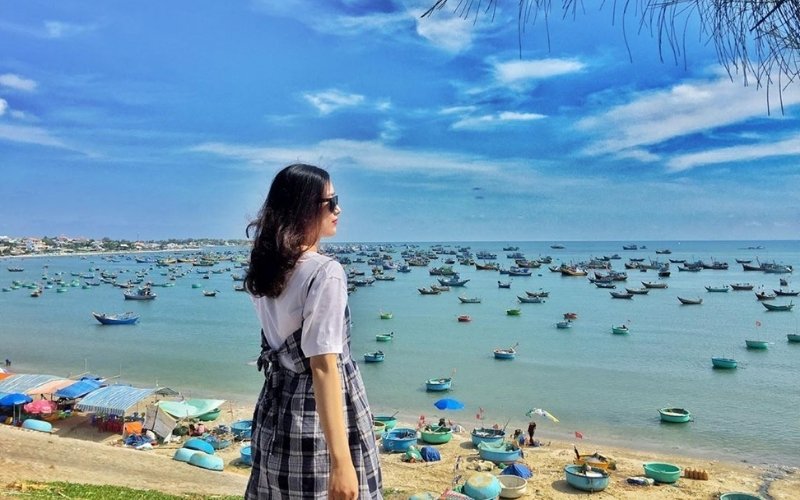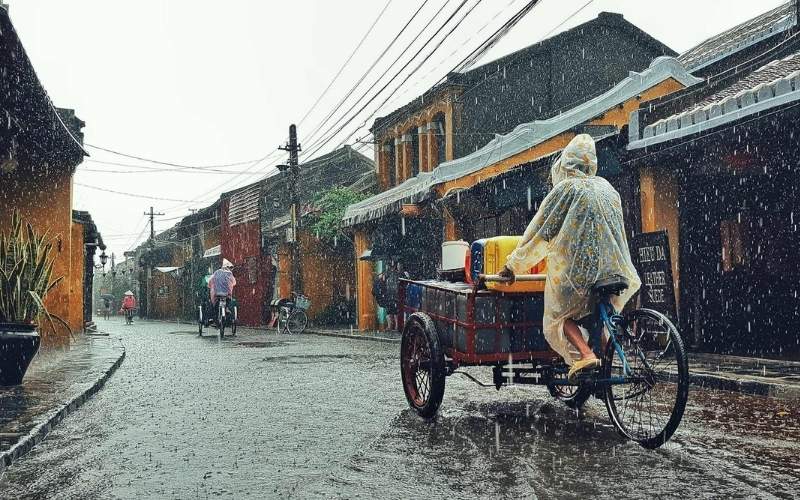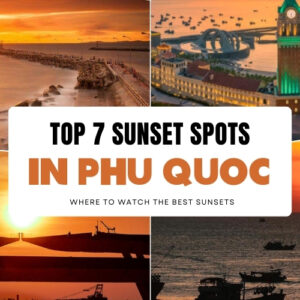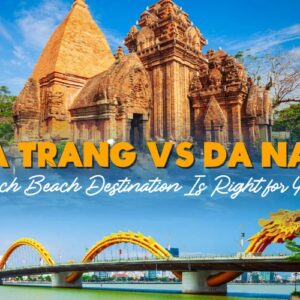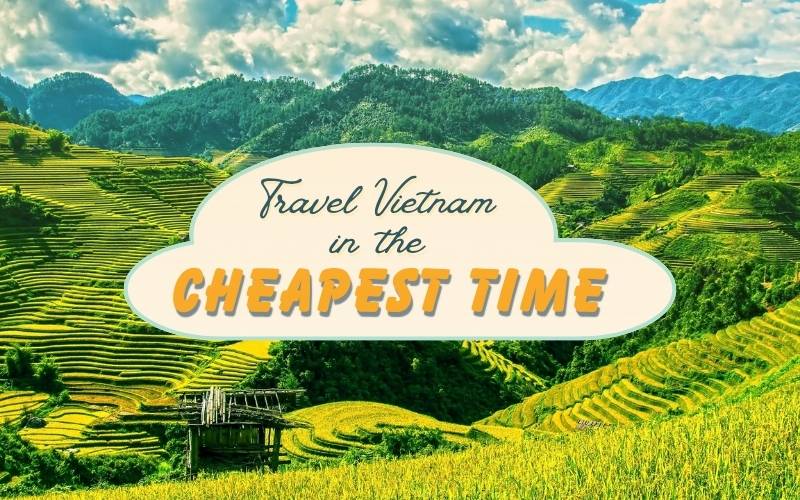
Vietnam presents itself as a stunning S-shaped nation which stretches across the East Sea. Nature has blessed this country with multiple weather patterns and diverse cultural traditions and distinctive landscapes which change from one region to another. The Northwest mountains create a majestic backdrop to the Mekong Delta and Central coast which features long stretches of white sand beaches that each possess distinct characteristics and sounds and spiritual essence. So, what is the cheapest time to travel to Vietnam? The correct answer is from April to September. Why is that? Let IDC Travel explain this matter clearly. This article also offers essential Vietnam travel tips for those planning a money-saving travel adventure across this stunning country.
Why Is April To September The Cheapest Time To Travel To Vietnam
April to September is considered the cheapest time to travel to Vietnam because it’s the best time for money-saving travel — fewer international visitors, more local promotions, and plenty of good travel deals. During these months, the weather can be hot and a bit rainy, especially in the north and south, but that also means hotels, flights, and tours often drop their prices to attract travelers. If you don’t mind occasional showers, this period can actually be a great opportunity to explore Vietnam with fewer crowds, enjoy more personal service, and experience the country’s authentic daily life at a slower, more relaxed pace.
Overview Of Vietnam’s Climate
Vietnam’s tropical climate generates three separate travel seasons which include low and shoulder and peak periods that bring distinct weather conditions throughout the entire nation. Understanding how these patterns shift helps travelers identify the cheapest time to travel to Vietnam for their itinerary. The chart below gives you a quick overview before we dive into each region.
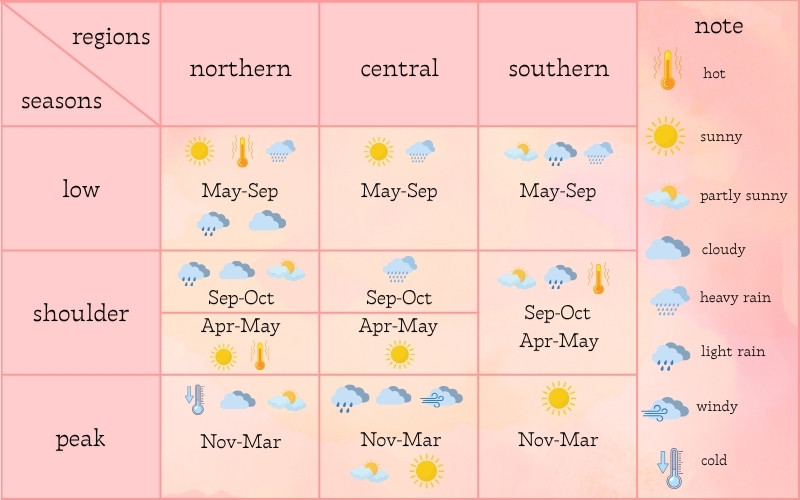
Vietnam’s weather varies by region.
1. Northern Vietnam — Where Four Seasons Tell Four Stories
Northern Vietnam stands as a region which shows different sides through its foggy mountain landscapes and old town streets and golden rice fields that experience four different seasons. The Old Quarter of Hanoi reveals poetic beauty while Ha Long Bay presents stunning views and Ha Giang offers untamed natural splendor which makes each place seem like it belongs to a different time. The seasons of spring and autumn bring a special kind of magic through their mild temperatures and the way the sunlight creates a softer appearance in the environment. The destination welcomes visitors who want to explore cultural heritage sites while discovering natural landscapes throughout their entire vacation.
It has four seasons:
- Spring (Feb–Apr): The season starts with comfortable weather while flowers begin to bloom and morning fog settles over the land.
- Summer (May–Aug): The weather becomes hot and humid during this period while domestic travelers fill up the area.
- Autumn (Sep–Nov): The cool air breathes life into the season while golden leaves cover the ground and tourist numbers decrease to create a perfect environment.
- Winter (Dec–Jan): The cold climate creates a special feeling that becomes most noticeable when you reach the mountain regions.

Vietnam through the four seasons: from spring blossoms and summer beaches to autumn colors and winter snow.
The standard 5-day Northern Vietnam affordable tour costs between 250–400 USD per person during low season when flights are not included in the cost.
2. Central Vietnam — The Land of Sun, Sea, and Heritage
Central Vietnam brings together historical traditions of Hue’s royal period with the present-day coastal areas of Da Nang and the illuminated lantern festivals of Hoi An. The area receives abundant sunshine between February and August which makes it an ideal destination for beach enthusiasts and outdoor seekers. The area shows its peaceful personality during the rainy season from September to November. This low season atmosphere adds a soft, nostalgic charm to Hue and Hoi An. Central Vietnam welcomes visitors with its warm climate and friendly people no matter if they visit imperial tombs or enjoy the beach at An Bang.
It has two seasons:
- Dry season (Feb–Aug): The dry season brings hot weather along with bright sunlight which makes it perfect for beach activities at My Khe and An Bang.
- Rainy season (Sep–Nov): The rainy season brings brief rain showers and occasional storms but fewer tourists and discounted hotel rates.
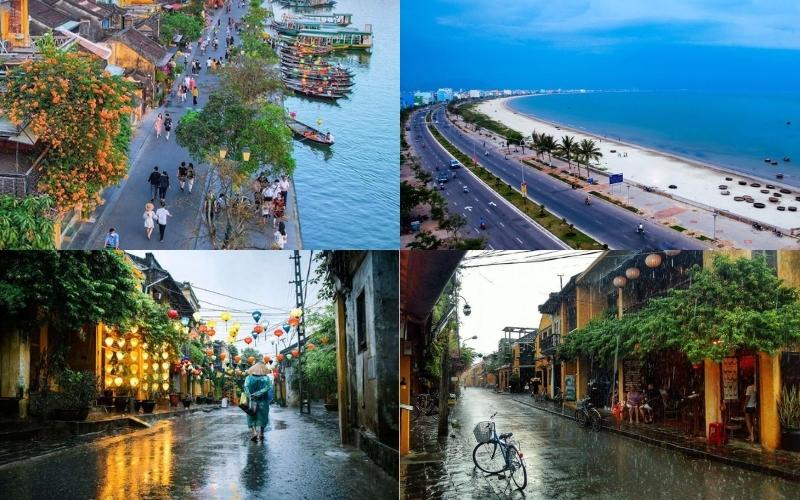
The two faces of Central Vietnam: bright and breezy in the dry season, calm and romantic in the rain.
The average cost for a 4 to 5 day tour in Central Vietnam reaches between 200 and 350 USD while beach resorts offer rates as low as 30 USD per night.
3. Southern Vietnam — The Endless Summer
Down south, it’s summer all year long. From the vibrant chaos of Ho Chi Minh City to the slow rhythms of the Mekong Delta and the turquoise waters of Phu Quoc, the South is full of color and energy. People can experience the tropical freshness during the rainy season (May to October) and enjoy bright sunshine throughout the dry period which lasts from November to April. The area maintains constant activity because it combines street food vendors with friendly faces and authentic southern hospitality. Those who travel during the low season in the south often find local life more authentic and welcoming.
It has two seasons:
- The dry season lasts from November through April when the weather stays sunny which makes it a great time for island visits and river cruises.

The dry season brings clear skies and calm seas — the perfect time to explore Vietnam’s sunny southern coast.
- The rainy season occurs from May through October when short afternoon rain showers appear but the area becomes green and there are fewer tourists.

A rainy afternoon in Hoi An — when the ancient town slows down under the soft rhythm of tropical rain.
The cost for four days in Southern Vietnam amounts to between 180 and 300 USD. During the rainy season Phu Quoc resorts provide discounts of 40 to 60 percent on their prices. This makes the south one of the top choices for money-saving travel during the year.
The sudden rain showers make many people reluctant to travel but experienced travelers understand that the rainy season provides an ideal opportunity to discover Vietnam through a relaxed and money-saving travel experience. The number of international and domestic tourists falls dramatically throughout this period which creates lower costs for air travel and accommodation and guided tours throughout the entire country.
The “Fresh Green” Beauty of Vietnam For Saving-money Travel
After summer rains, Vietnam seems washed clean, becoming fresher and more vibrant than ever. The country experiences a burst of fresh life from June through October which marks the peak season for natural growth. The air turns cooler while the plants display their vibrant green color and the rivers and waterfalls become full which reveals the connection between the earth and the sky.
1. Northern Vietnam
The terraced rice fields of Sapa and Mu Cang Chai and Ha Giang in northern Vietnam become natural wonders when the summer rains arrive. The fields start to shine with water as the rain ends while clouds float across the mountain summits which creates a scene that looks like a watercolor painting. The rice fields transform into golden landscapes during the late season of September to October which attracts photographers and travelers who want to experience the “golden season”.
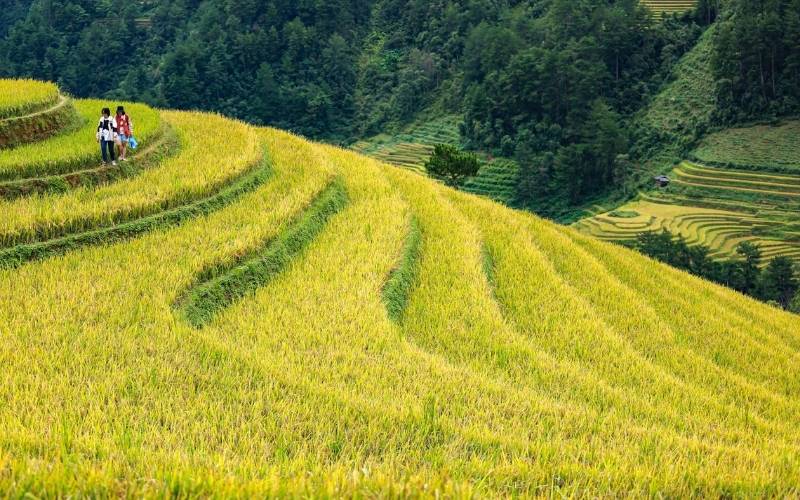
Golden harvest season in Ha Giang — when terraced rice fields turn into breathtaking waves of yellow under the mountain sun.
Suggested affordable tour for you:
Day 1: Hanoi to Ha Giang – Drive through stunning mountain landscapes, stop at the 15th-century Mac Dynasty Citadel and local market in Tuyen Quang. Overnight in Ha Giang.
Day 2: Ha Giang to Meo Vac – Visit Quan Ba, Yen Minh, and Dong Van. Cross the spectacular Ma Pi Leng Pass with panoramic views of the Nho Que River. Overnight in Meo Vac.
Day 3: Meo Vac to Bac Me – Visit Meo Vac market, travel back through scenic mountain routes to Bac Me. Explore a Tay ethnic minority village.
Day 4: Bac Me to Cao Bang – Enjoy breathtaking scenery through three mountain passes before reaching Cao Bang.
Day 5: Cao Bang to Ban Gioc Waterfall to Cao Bang – Discover Ban Gioc, one of Vietnam’s most beautiful waterfalls, and visit Nguom Ngao Cave with its magnificent stalactites.
Day 6: Cao Bang to Lang Son to Hanoi – Stop at Lang Son market before returning to Hanoi. End of tour.
>>> View full detail in Viet Nam Northeast 6 Days From Ha Giang To Lang Son
The best period to save money for traveling falls between May and September when terraced fields reach their peak beauty because they transform into flooded landscapes or golden hues which create stunning views that attract hikers and photographers.
2. Central Vietnam
In the Central region, the rain brings a quiet, romantic charm. The rain transforms Hue into a poetic city by creating musical sounds that bounce off the ancient palace rooftops and Hoi An becomes nostalgic when its streets become illuminated by lantern reflections. Da Nang keeps its vibrant atmosphere during rainy weather because its Han River cafes provide warm comfort and its spas offer relaxation and its malls serve as dry shopping destinations.

The breathtaking Golden Bridge in Ba Na Hills, Da Nang — where sunrise meets the sky above the clouds.
Suggested affordable tour for you:
Day 1: Buon Ma Thuot arrival – Pick up and transfer to hotel. Visit Dak Lak Museum of Ethnology and the World Coffee Museum to learn about the region’s rich culture and coffee heritage.
Day 2: Buon Ma Thuot to Lak Lake – Visit ethnic villages (Hmong, Ede) and local coffee & pepper farms. Explore Bao Dai’s Palace, enjoy an elephant ride and boat trip on Lak Lake, and watch the sunset over the water.
Day 3: Lak Lake to Buon Ma Thuot – Return journey with photo stops. Discover Dray Nur Waterfall and visit Ban Don Village. Enjoy coffee at Akothon Village’s Arul House, surrounded by traditional ethnic décor.
Day 4: Buon Ma Thuot to Pleiku – Drive to Pleiku. Visit Bien Ho Lake, Bien Ho Tea Plantation, Minh Thanh Pagoda, and the Central Market.
Day 5: Pleiku to Kontum – Visit the wooden church and orphanage in Kontum, then explore a Bana ethnic village and the famous Rong Communal House.
Day 6: Kontum departure – Breakfast and transfer to Pleiku Airport for your next destination.
>>> View full detail in Journey through Wonders of Central Vietnam 6 Days
The recommended travel period to save money exists between September and November when the weather provides clear skies with mild sunshine which creates an ideal environment for both beach relaxation and heritage exploration.
3. Southern Vietnam
The Mekong Delta region in South Vietnam transforms its rainy season into the “flooding season” which produces fertile conditions that lead to abundant harvests. The cities of Can Tho, An Giang, Long An, and Dong Thap will reach their peak level of life. The floating markets and cajuput forests together with lotus fields and flooded rice paddies create a tranquil rural scene. Phu Quoc keeps its charm during rainy weather through its peaceful beaches and dense forests and budget-friendly accommodations.
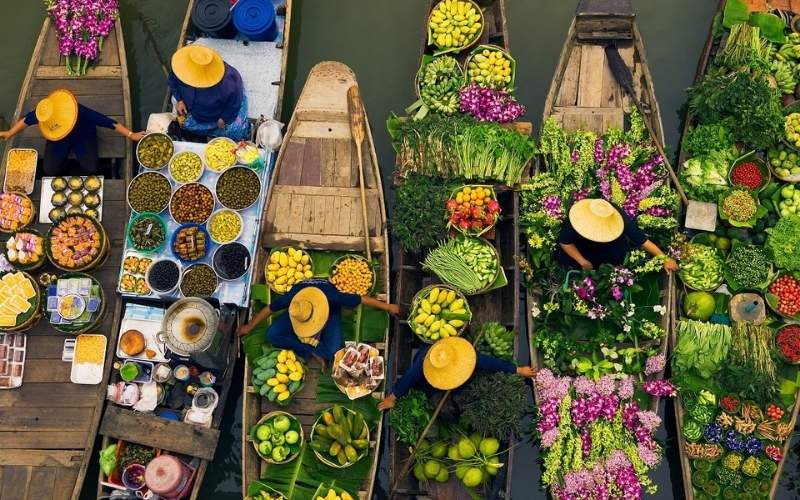
The floating markets of Vietnam — a lively blend of colors, culture, and daily life on the water.
Suggested affordable tour for you:
Day 1 : Nha Trang Arrival at Cam Ranh International Airport (CXR), transfer to hotel.
Day 2 : Nha Trang Boat Trip to Islands: Snorkeling, swimming, and relaxing on scenic islands. City Tour: Visit attractions like the Po Nagar Cham Towers or Long Son Pagoda.
Day 3 : Nha Trang – Da Nang: Morning flight/transfer from Nha Trang to Da Nang. Check-in and explore the modern coastal city.
Day 4 : Da Nang Free Time for Beach Relaxation: Enjoy the pristine sands of My Khe Beach (one of the world’s most beautiful beaches). Optional: Visit Son Tra Peninsula or Marble Mountains.
Day 5 : Da Nang – Hoi An: Transfer from Da Nang to Hoi An. Afternoon check-in and explore Hoi An Ancient Town by foot.
Day 6 : Hoi An Hoi An Visits: Explore the Japanese Covered Bridge, ancient houses, local markets, and tailor shops. Optional: Cooking class or cycling in the rice paddies.
Day 7 : Hoi An Free Time: Relax, enjoy a coffee by the river, cycle to An Bang beach, or indulge in shopping and bespoke tailoring.
Day 8 : Hue Hue City Tour: Day trip (or move) to Hue. Explore the Imperial Citadel, the Forbidden Purple City, and one of the majestic Royal Tombs (e.g., Khai Dinh or Tu Duc).
Day 9 : Transfer to Da Nang International Airport (DAD) or Phu Bai Airport (HUI) for your departure.
So you can enjoy nice weather and affordable prices for the entire itinerary stretching from Nha Trang, Da Nang, Hoi An to Hue, the most ideal time is March or late September/early October.
The low season provides more than affordable prices because it creates an environment of calmness. The streets of Hanoi become shiny from rain while cicadas produce their melodies during Saigon’s raindrops and Hoi An presents a special moment when lanterns twinkle by the river after rainfall. Traveling during the low season reveals the experience of shrinking into the natural world while your entire being connects to life’s rhythms. For budget-conscious travelers, this rainy stretch doubles as the cheapest time to travel to Vietnam without sacrificing experience.
Vietnam Travel Tips for a Perfect Trip
- Choose the low season or shoulder season for money-saving travel: Travel during the months of September to October because this period offers the best discounts on various services which will help you save money.
The most trustworthy flight search websites Google Flights, Skyscanner and Kayak have provided information which we used to create the following table of air ticket prices from different continents to Vietnam:
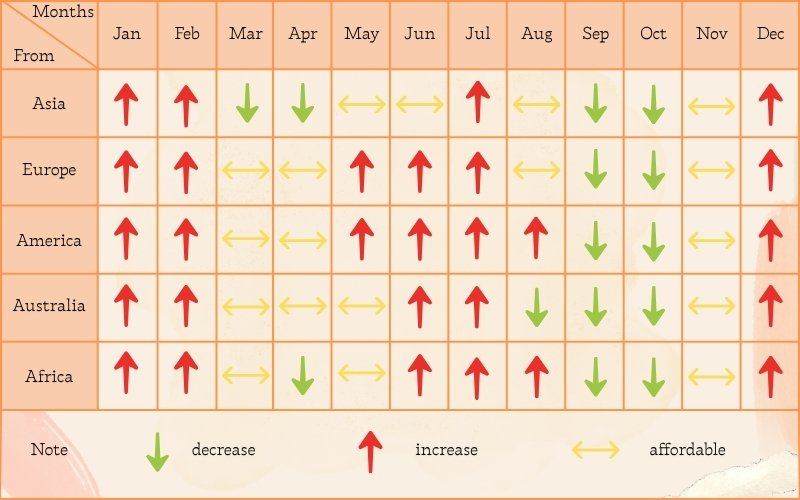
Flight prices to Vietnam fluctuate by season, rising during global holidays and dropping in May and September — the best months for affordable travel.
- Avoid major holidays: Traveling during Tet (Lunar New Year) and April 30 – May 1 and September 2 will result in higher prices and overcrowded destinations.
- Enjoy the low season properly: You should pack a light raincoat together with non-slip shoes and waterproof phone bags to stay safe during the low season. People should schedule their outdoor sightseeing activities for the morning because rain showers tend to occur less frequently during this part of the day.
- Eat local: The best way to experience Vietnamese cuisine is to visit night markets and local restaurants because they offer tasty dishes at affordable prices which showcase authentic regional flavors.
>>> Don’t wait until prices go up – book 10 Days Vietnam Highlights Tour for Family now to plan a smart, affordable, and fulfilling journey!
Many people often wait until the peak season to travel, but those who truly understand Vietnam prefer the low season. That’s when the country becomes more peaceful, greener, and the best time for a money-saving travel. The rain makes the streets of Hoi An come alive while Da Nang’s Dragon Bridge disappears into the mist and the Mekong Delta’s cajuput forests create soothing water sounds which together form an unforgettable experience.
The low season is coming — and Vietnam is waiting for you, in the gentle green of the sky and earth, in the sound of rain on tiled roofs, and in the warm smiles of its people. Traveling in Vietnam doesn’t cost much — you just need to choose the right time. Contact us today to save money while we help you discover meaningful experiences and new perspectives about this S-shaped land.
Read more:

